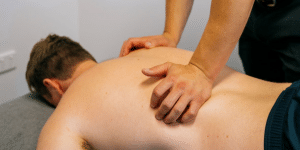How to reduce your risk of knee and ankle injury by 50%

Despite the alarmingly high rates of sporting knee and ankle injuries in Australia, it is estimated that between 35-50% of these injuries are preventable by engaging in exercise-based prevention programmes. Ask anyone who has had a knee reconstruction or nasty ankle sprain and they’ll tell you it is an experience worth avoiding! At a team level, there is a strong link between injury rates and team performance – lower team injury rates result in better performance.
Understanding the benefits of injury prevention is the first step. But how do you actually implement an effective prevention program?
As physiotherapists, our job is to provide advice that will help to keep you on the sporting field, swimming in the pool, riding your bike, lifting weights at the gym, and completing your weekly parkrun. We’d prefer that you didn’t miss out on doing the things you enjoy, so here are three warm-up programs for soccer, AFL, and netball that have been proven to prevent injuries.
Specific injury prevention training programs
Soccer: FIFA 11+
FIFA 11+ is an effective injury prevention program developed by FIFA. It is designed to be used as a specific warm-up before training sessions and games. There are three parts: running, strength/balance and advanced running exercises, which takes approximately 20 minutes to complete. Research has shown the FIFA 11+ reduced the rate of lower limb injury by 39% among male and female players. Additionally, it has been shown to reduce knee injuries in females by 52%.

FIFA 11+ is available here
AFL: FootyFirst
FootyFirst is a 5-level progressive exercise program specifically targeted at preventing common lower limb injuries in community Australian football players. It was designed to replace the traditional warm up used at football training. It takes about 20 minutes to complete and does not require any special equipment. Studies have shown that training programs similar to the FootyFirst have been effective in reducing the risk of acute knee and ankle injuries by 54% and 50% respectively.

FootyFirst is available here
Netball: KNEE Program
Developed by Netball Australia, with the assistance of the Australian Institute of Sport, the KNEE program is an on-court warm-up program designed to reduce the risk of serious knee injuries (e.g. ACL injuries). The program targets three specific groups of players: junior, recreational, and elite, with different exercises tailored to match the fitness and ability level of each group. The KNEE program is based on other prevention programs that have proven to be effective in reducing lower limb injuries generally, and more specifically, reducing ACL injuries by 40-70%.

Netball Australia’s KNEE program is available here
These programs aren’t limited to use in just soccer, netball, and AFL. Many of the exercises are applicable to a wide variety of sports, so we encourage you to try it, even if you are in a different sport.
So I’ve got my warm-up sorted – is there anything else I can do?
In this blog we have covered how a specific warm-up routine can prevent injury. The other side of the injury coin relates to the volume of your activity – how much you train, how often, and how hard. Rapid increases in training volume can lead to increased risk of injury; for more information about training load and injury risk, have a read of our recent blog: Preventing Injury by Monitoring Training Load.
If you have any questions, please contact us here or book an online appointment
References:
- Silva, P. V., Kamper, S. J., & Costa, L. D. C. M. (2017). Exercise-based intervention for prevention of sports injuries (PEDro synthesis). British journal of sports medicine.
- Bengtsson, H., Ekstrand, J., & Hägglund, M. (2013). Muscle injury rates in professional football increase with fixture congestion: an 11-year follow-up of the UEFA Champions League injury study.Br J Sports Med,47(12), 743-747.
- Hübscher M, Refshauge KM. Neuromuscular training strategies for preventing lower limb injuries: what’s new and what are the practical implications of what we already know?British Journal of Sports Medicine.2013;47(15):939-940






